Need to accelerate your server or increase the budget for storage? The decision between SAS and SATA will determine the correct performance, reliability, and value for your unique needs. Be it a high-performance data center or a cost-effective desktop storage, it can save you time and money to understand the differences between these two storage interfaces.
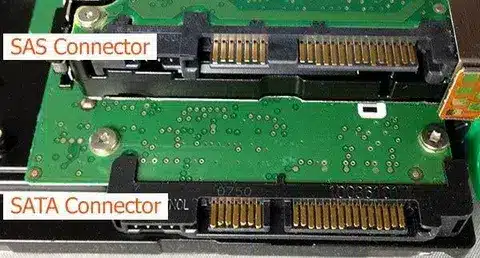
This is a complete guide that SAS vs SATA performance, SAS vs SATA reliability, and assists you in making a decision, which is better, SAS or SATA, in your specific case.
What Are SAS and SATA?
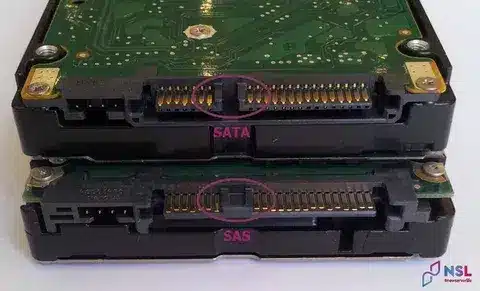
SAS (Serial Attached SCSI) and SATA (Serial ATA) are storage interfaces designed to connect hard drives and solid-state drives with computer systems, but each interface serves a different market segment and performance need.
SAS is an extension of the parallel SCSI, which was created with very specific enterprise environment requirements in mind, and requires a high-performance, high-reliability, and feature-rich interface. SATA, however, was based on the more ancient PATA (Parallel ATA) standard, with the aim of affordability and ease of use by consumers and light commercial users.
Both interfaces are based on serial communication protocols; however, the design philosophies and capabilities of the two interfaces vary widely and affect performance, reliability, and costs.
Technical Comparison: SAS vs SATA Performance and Features
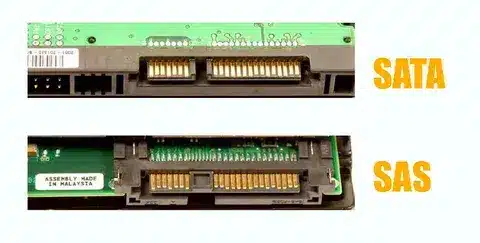
Speed & Throughput
SAS provides high speed and can communicate full-duplex:
- The maximum transfer rate supported by the current SAS-4 is 22.5 Gb/s.
- Full-duplex can be used to perform both read and write operations simultaneously.
- Stable operation in high loads.
SATA. Most applications can be done at a respectable speed
- SATA III has a maximum transfer rate of 6 Gb/s.
- Half-duplex communication is restricted to read or write.
- Under conditions of heavy multitasking, performance can be impaired.
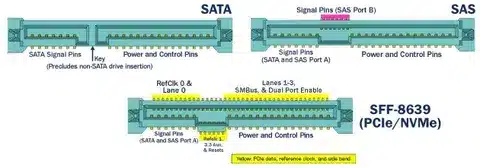
Duplex & Command Handling
The difference in the performance between SAS and SATA is most evident in the handling of the commands:
SAS advantages:
- Dual-port full-duplex communication.
- Native command queuing size 254 commands.
- Several initiators may receive the same drive at the same time.
SATA characteristics:
- Single-port Half-duplex design.
- Native command queue size 32 commands.
- A less complex architecture that can be used by single users.
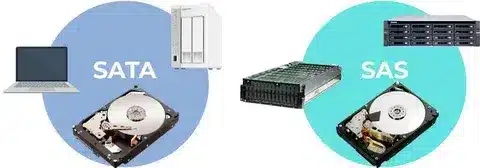
Reliability & Enterprise Features
In terms of SAS vs SATA reliability, SAS is definitely aimed at mission-critical use:
SAS reliability features:
- Increased Mean Time Between Failures (MTBF).
- High-level error detection/recovery.
- Redundant data path Multipath I/O.
- Most implementations are hot-swappable.
SATA reliability profile:
- Less expensive design, fewer enterprise protections.
- Simple error correction that can be used by consumers.
- Low redundancy properties.
- Reliable storage needs that are not critical.
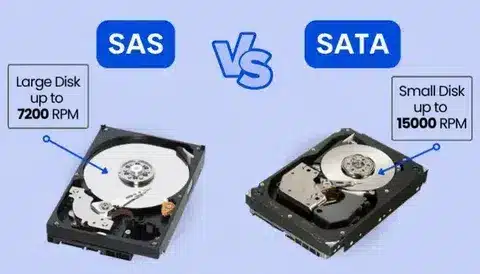
Compatibility & Cabling
Compatibility advantages:
- SAS controllers are able to support both SAS drives and SATA drives.
- SATA drives cannot be used in SATA controllers.
- Such one-way compatibility gives flexibility in upgrading.
Cabling differences:
- SAS is capable of supporting longer cable runs (10 meters).
- Rugged connectors, a more rugged design of connectors to be used in a server environment.
- There are cable length constraints as well as voltage constraints in SATA.
- SATA connectors are easier and cheaper.
Price & Cost per GB
The decision on which is better, SAS or SATA, is largely dependent on the cost equation:
SATA cost advantages:
- Much lower price per gigabyte.
- In consumer markets, in large quantities.
- The low complexity in manufacturing makes prices competitive.
SAS cost considerations:
- Enterprise-grade components at premium prices.
- Increased cost at start compensated by stability and output.
- The total cost of ownership can be reduced in the enterprise case.
Use Cases & Scenarios
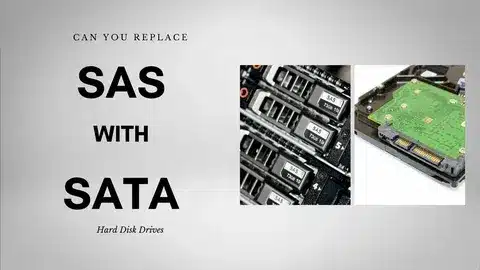
Consumer & Desktop Storage (SATA)
SATA is best suited in consumer settings where cost is the most important consideration:
Ideal applications:
- Personal computers and game systems.
- External backing.
- Workstations and media libraries.
- Small office file servers
Key benefits:
- Low-cost high high-capacity storage.
- Sufficient transfer rate in standard desktop loads.
- Broad support of consumer hardware.
- Easy installation and setup.
Servers, Workstations & Data Centers (SAS)
SAS is a leader in systems where performance and reliability are paramount:
Optimal scenarios:
- Database servers can be high-performance.
- Multi-workload virtualization hosts.
- Applications that have high uptime demands and are mission-critical.
- RAID arrays that need stability.
Enterprise benefits:
- Excellent RAID performance and efficiency.
- Fault tolerance Multipath I/O.
- Increased ability to work 24/7.
- Improved management of simultaneous access by users.
Hybrid Environments
Hybrid deployments tend to integrate the two technologies:
- Fast SAS drivers of operating systems and often-used databases.
- Backup storage and archival data on large-capacity SATA drives.
- Optimized cost and performance tiered storage strategies.
- Scalable configurations that are responsive to changing needs.
Key Differences Summary
| Feature | SAS | SATA |
| Maximum Speed | Up to 22.5 Gb/s | Up to 6 Gb/s |
| Communication | Full-duplex | Half-duplex |
| Command Queue | 254 commands | 32 commands |
| Reliability | Enterprise-grade | Consumer-grade |
| Price Range | Higher cost | Budget-friendly |
| Compatibility | Backward compatible with SATA | SAS drives are not supported |
| Cable Length | Up to 10 meters | Limited length |
| Target Market | Enterprise/Server | Consumer/Desktop |
SATA can be considered a highway lane that only single-car traffic can pass smoothly, whereas SAS is a multi-lane superhighway that has redundancy, traffic management systems, and infrastructure that is constructed to support heavy commercial traffic.
Frequently Asked Questions
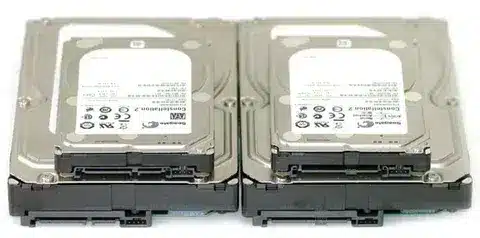
Can you plug a SATA drive into a SAS controller?
Yes, SAS controllers are compatible with SATA drives. This is because you can use low-cost SATA storage to run less critical applications and still have the option of upgrading to the SAS drives when the data is required.
Why are SAS drives more expensive?
Enterprise-grade features such as dual ports, advanced error correction systems, stronger mechanical designs, and a significant amount of validation testing increase the cost of SAS drives. The characteristics guarantee the dependability of the work in the challenging 24/7 conditions.
How much faster is SAS compared to SATA?
Depending on the generation comparison, 2-4x faster transfer rates can be achieved with SAS. But practical performance disparities are highly workload-dependent, with SAS exhibiting the most benefits in multi-user, high-concurrent workloads.
When should I choose SATA over SAS?
Use SATA when the budget is the main constraint, storage space is required in bulk, and the performance requirements are moderate. SATA is very effective in backup storage, media files, and applications used by one user.
Is SAS worth the extra cost?
SAS is worth the higher cost in a system where downtime expenses are higher than the price distinction, numerous users share the storage at the same time, or the information is vital. Divide the total cost of ownership by your possible downtime and costs.
Conclusion & Recommendation
Generally, when you require cheap high-capacity storage, use SATA. When having good value on your desktop computer, media storage and backup applications are important; when peak performance is not a big concern, then it is a great interface.
SAS is not cost-effective unless you have a mission-critical and high-throughput environment. Rather, SAS is the apparent one to use when applications, databases, and servers require high performance and reliability in uptime, since the more preferable the SAS vs SATA performance and SAS vs SATA reliability features, the better.
The question of which is better, SAS or SATA, is ultimately dependent on your requirements. Assess your performance goals, financial constraints, and workload patterns before determining what action to take. You may always begin with a hybrid approach, do you not know–store the valuable information in SAS and less valuable data in SATA.
It should be noted that storage is generally a long-term investment. When making your decision, you should not only look at the initial costs, but also at potential expansion, required maintenance, and the cost of not doing anything.





